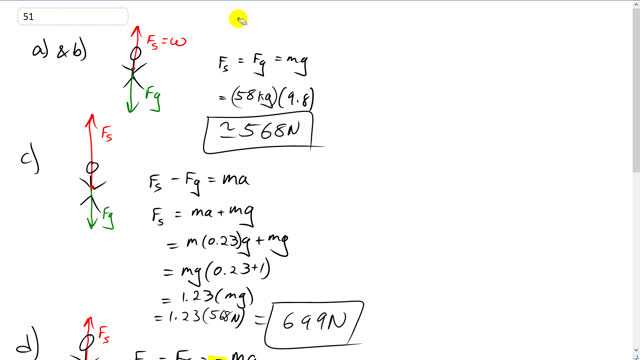
What will a spring scale read for the weight of a 58.0-kg woman in an elevator that moves
- upward with constant speed
- downward with constant speed 5.0 m/s
- with an upward acceleration 0.23 g,
- with a downward acceleration 0.23 g, and
- in free fall?

In order to watch this solution you need to have a subscription.
This is Giancoli Answers with Mr. Dychko. In both the parts (a) and (b), where this person is moving at constant speed, upwards or downwards, doesn't matter, you get the same picture for the free-body diagram. You have the upwards force exerted by the spring scales equal to the downward force of gravity. And so that will make the upward force equal to the weight because it's equal to gravity. And the weight is mg. So, the spring scale will read 58 kilograms times 9.8 newtons per kilogram, which is 568 newtons. In part (c), the spring force upwards is larger than the gravity down. And we'll take up to be the positive direction, in which case, we'll have spring scale being positive minus the gravity force down equals mass times acceleration. And we can add F g to both sides, or move it to the right and it becomes positive F g, which turns into mg. Factor out the m and the g because the acceleration here is 0.23g. And so we'll factor out the m and the g there. And you have mg times 1 plus 0.23 which is 1.23 times 568 newtons, where I have substituted 568 in place of mg because that's what we have calculated up here. And 699 newtons will be the reading on the spring scale there. For part (d), the spring scale force is still up, of course, and the gravity is pulling down. But the acceleration is now downwards so I'll put a negative sign in front of that acceleration. And I'm just gonna put the magnitude in for the letter A. So, the magnitude will be 0.23 of g and this gravity gets moved to the right-hand side and that turns into mg. And we can factor out the m and the g and we have 1 minus 0.23 now so that's 0.77 times 568, which is 440 newtons, will be the spring scale reading in this case. So because the spring scale, is not exerting enough force upwards to equal the weight, there's gonna be an acceleration downwards. And then in part (e), in free-fall, that means there's no spring scale force upwards; it's often called a normal force but in this case, there's no surface. Normal force is typically, a force perpendicular to a surface. So, I'm putting an S here for spring scale. No spring scale force because there's free-fall and so spring scale will read zero.